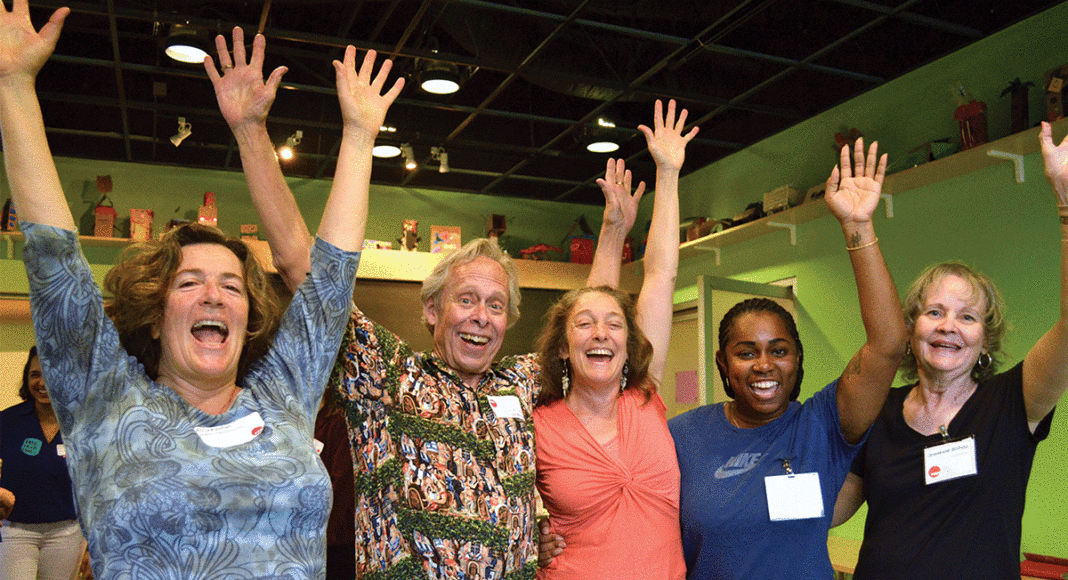There are many counterintuitive things about laughter yoga. For one, you don’t need a yoga mat. “The word ‘yoga’ means union. That’s what we’re going to be doing tonight. We’re going to unite laughing with deep breathing,” says Carla H. Brown, a health and wellness expert and laughter and levity professional for the past 10 years. Wearing a satsuma-orange shirt and a beaming smile, Brown is leading the Wednesday evening laughter yoga class at the Tannery, which consists of a dozen or so attendees standing in a circle—some of them veterans, and some self-conscious virgins like myself.
You also don’t need a sense of humor: “The laughter is going to start off fake and simulated,” Brown tells us. “But it’s going to become contagious, because that just happens with humans.”
The point is to laugh for no reason at all other than because we can. And that’s exactly what we do for the next 45 minutes, as Brown leads us through various exercises that transform the group into children—or primates, really—doubling over in laughter as all of the cares and worries of daily life evaporate into guffaws, gesticulations and a wild, ridiculous display of silliness. Because, while the mind knows the difference between real and simulated laughter, the body doesn’t—and the physiological effects of an evening spent forcing laughter are immense. Most notably, it’s a powerful tool for mediating stress.
“In our world, we get a lot of cortisol, but we don’t always get to run or walk it off. So it continues to run in our system, and it keeps affecting us for a longer period of time,” says Alicia Kosman, a former hospice nurse and trained laughter leader for the past two years.
Indeed, the stress hormone cortisol is a known cause of many diseases, and a mounting body of evidence has shown laughter to decrease its levels in the body.
“When we are laughing, we’re also breathing,” says Brown. “And when we stress out, we stop breathing, we cut off our oxygen supply to our brain, we become stupid, we go into fight or flight, we release cortisol, which is also an aging hormone.” says Brown. When we laugh, blood flow increases—while stress constricts blood vessels—and feel-good chemicals like dopamine, serotonin, and oxytocin are released. Blood pressure is lowered after a good laugh, and the immune system gets a boost. We become present, alive, and connected with our bodies.
But even while no yoga poses are employed in laughter yoga, it’s a legitimate exercise.
“Ten minutes of deep belly laugh—they call it hearty belly laughter in the industry—is like 30 minutes on the rowing machine,” says Brown. Laughter also invigorates the internal organs, and maintains a healthy endothelium, reducing the risk of cardiovascular disease, heart attack and stroke. By the time we’ve reached the final savasana stage of deep relaxation—following a three-minute climax of straight laughter—lying on the floor, bathing in those feel-good chemicals, I am physically and emotionally spent.
“There’s a lot of people for whom the e-word, exercise, is loaded with shame and guilt. But if we can disguise it with something playful, they’re still getting the movement,” says Brown, noting that the practice has been excellent for seniors as well as for helping Parkinson’s sufferers relieve their pain.
Conceived by Madan Kataria, M.D., a physician in Mumbai, India, in 1995, laughter yoga as a “wellbeing workout” has expanded from just a few people in a park to an international phenomenon with thousands of social laughter clubs sprouting up in more than 65 countries. “The first time I tried it, I thought it was the stupidest thing I’d ever done,” says Brown. “I did it for 10 minutes, and it changed my entire day, but I still thought it was stupid.”
Now she’s at the forefront of a growing laughter yoga movement, locally and beyond, leading weekly classes at the Tannery, and bi-weekly sessions for women with cancer in WomenCARE, as well as multiple-week class series through Parks and Rec and trainings for corporations and businesses.
“It changed my life,” says Brown, who says her laughter practice helped her counter the stress of her life as a former perfectionist and control freak. “Your life is worth more than the stress that you give yourself and feed yourself every day—whether you’re in a career, or you’re parenting, or you’re caring for someone, or your own life is just filled with a ton of stress that you didn’t expect. In the long term, in five years, you will not remember the circumstance, but your body will. So the more that you invest your time and energy in cultivating joy and aliveness through things like laughter yoga, the more you can enjoy your life while we still have it.”
Brown will lead six-week laughter yoga series ‘Hardwire Happiness with Laughter Yoga’ ($88) at Louden Nelson Community Center, 5:30 p.m. on Thursdays beginning Jan. 26 and April 27; and ‘Laughter Meditation for Mindfulness’ ($98) beginning March 9. Brown leads regular classes at 5:30 p.m. Wednesdays at the Tannery ($10-13), at 12:30 p.m. on first and third Thursdays for members of WomenCARE (Free), and will be participating in the MAH’s Power Hour from 7-8 p.m. on Friday, Jan. 20. For more information visit Laughter Yoga Santa Cruz on Facebook, meetup.com/Santa-Cruz-Laughter-Yoga, or call Carla H. Brown at 806-392-5768.













